Zingiber officinale var. rubrum: Red Ginger’s Medicinal Uses
Abstract
:1. Introduction
2. Chemical Constituents of Red Ginger and Its Biosynthesis
Biosynthesis of Vanilloids
3. Biological Activities and Molecular Mechanisms of Red Ginger
3.1. Antimicrobial Activity
3.2. Analgesic and Antihyperalgesic Activity
3.3. Antidiabetic Activity
3.4. Anti-Inflammatory Activity
3.5. Antioxidant and Free Radical Scavenging Activity
3.6. Anticancer and Antitumor Activity
3.7. Antihyperlipidemic, Antihypertensive, and Antihypercholesterolemic Activity
3.8. Neuroprotective Effect
3.9. Androgenic Effect
3.10. Insecticidal Activity
3.11. Immunomodulatory Activity
3.12. Melanogenesis Inhibitory Activity
4. Analysis and Quality Control
4.1. The Application of Analytical Methods for Assessing Red Ginger’s Quality
4.2. Chemical Fingerprint Analysis
5. Medicinal Products
6. Our Perspectives
7. Conclusions
Author Contributions
Funding
Conflicts of Interest
References
- Syafitri, D.M.; Levita, J.; Mutakin, M.; Diantini, A. A Review: Is Ginger (Zingiber officinale var. Roscoe) Potential for Future Phytomedicine? Indones. J. Appl. Sci. 2018, 8, 30. [Google Scholar] [CrossRef] [Green Version]
- Setyawan, A.D.; Wiryanto, W.; Suranto, S.; Bermawie, N. Short Communication: Variation in isozymic pattern of germplasm from three ginger (Zingiber officinale) varieties. Nusant. Biosci. 1970, 6, 113. [Google Scholar] [CrossRef]
- Safitri, A.R.; Evanuarini, H.; Thohari, I. The Potential of Local Ginger as Antioxidant on Full Fat Mayonnaise. J. Ilmu dan Teknol. Has. Ternak 2019, 14, 90–98. [Google Scholar] [CrossRef]
- Sivasothy, Y.; Chong, W.K.; Hamid, A.; Eldeen, I.M.; Sulaiman, S.F.; Awang, K. Essential oils of Zingiber officinale var. rubrum Theilade and their antibacterial activities. Food Chem. 2011, 124, 514–517. [Google Scholar] [CrossRef]
- Kusumawati, N.; Anggarani, M.A.; Rusijono; Setiarso, P.; Muslim, S. Product standarization of ginger (Zingiber officinale rosc.) and red ginger (Zingiber officinale var. rubrum) simplicia through washing time, slice thickness and raw materials drying process optimization. Int. J. Adv. Sci. Eng. Inf. Technol. 2017, 7, 15–21. [Google Scholar] [CrossRef] [Green Version]
- Nishidono, Y.; Saifudin, A.; Nishizawa, M.; Fujita, T.; Nakamoto, M.; Tanaka, K. Identification of the chemical constituents in Ginger (Zingiber officinale) responsible for thermogenesis. Nat. Prod. Commun. 2018, 13, 869–873. [Google Scholar] [CrossRef] [Green Version]
- Nordin, N.I.; Gibbons, S.; Perrett, D.; Mageed, R.A.; Nafiah, M.A. Immunomodulatory Effects of Roscoe var. (Halia Bara) ON Inflammatory Responses Relevant to Psoriasis. Open Conf. Proc. J. 2015, 4, 76. [Google Scholar] [CrossRef] [Green Version]
- Koike, N.; Yoo, S.H.; Huang, H.C.; Kumar, V.; Lee, C.; Kim, T.K.; Takahashi, J.S. Transcriptional architecture and chromatin landscape of the core circadian clock in mammals. Science 2012, 338, 349–354. [Google Scholar] [CrossRef] [Green Version]
- Rinanda, T.; Isnanda, R.P. Zulfitri Chemical analysis of red ginger (Zingiber officinale Roscoe var rubrum) essential oil and its anti-biofilm activity against candida albicans. Nat. Prod. Commun. 2018, 13, 15–18. [Google Scholar] [CrossRef] [Green Version]
- Sri Nurestri Abd Malek, H. The Essential Oils of Zingiber officinale Variants. Malaysian J. Sci. 1970, 24, 37–43. [Google Scholar]
- Ghasemzadeh, A.; Jaafar, H.Z.E.; Karimi, E.; Ibrahim, M.H. Combined effect of CO2 enrichment and foliar application of salicylic acid on the production and antioxidant activities of anthocyanin, flavonoids and isoflavonoids from ginger. BMC Complement. Altern. Med. 2012, 12, 229. [Google Scholar] [CrossRef] [Green Version]
- Kakadiya, R.; Wu, Y.C.; Dong, H.; Kuo, H.H.; Yih, L.H.; Chou, T.C.; Su, T.L. Novel 2-Substituted quinolin-4-yl-benzenesulfonate derivatives: Synthesis, antiproliferative activity, and inhibition of cellular tubulin polymerization. ChemMedChem 2011, 6, 1119–1129. [Google Scholar] [CrossRef]
- Ghasemzadeh, A.; Jaafar, H.Z.E.; Karimi, E.; Ashkani, S. Changes in nutritional metabolites of young ginger (Zingiber officinale roscoe) in response to elevated carbon dioxide. Molecules 2014, 19, 16693–16706. [Google Scholar] [CrossRef] [Green Version]
- MohdDuran, A.; Rashid, K.; Ibrahim, H.; Jalil, M.; Mohd Yusof, Y.; Shamzir Kamal, S.; Efzueni, S.; Farzinebrahimi, R. Toxic trace elements in selected edible rhizomes of medicinal plants using INAA and ICP-MS techniques. Int. J. Complement. Altern. Med. 2017, 6, 1–4. [Google Scholar] [CrossRef] [Green Version]
- Ghasemzadeh, A.; Jaafar, H.Z.E.; Rahmat, A. Antioxidant Activities, Total Phenolics and Flavonoids Content in Two Varieties of Malaysia Young Ginger (Zingiber officinale Roscoe). Molecules 2010, 15, 4324–4333. [Google Scholar] [CrossRef] [Green Version]
- Ghasemzadeh, A.; Jaafar, H.Z.E.; Karimi, E. Involvement of salicylic acid on antioxidant and anticancer properties, anthocyanin production and chalcone synthase activity in ginger (Zingiber officinale roscoe) varieties. Int. J. Mol. Sci. 2012, 13, 14828–14844. [Google Scholar] [CrossRef]
- Ghasemzadeh, A.; Jaafar, H.Z.E. Effect of CO2 enrichment on synthesis of some primary and secondary metabolites in ginger (Zingiber officinale Roscoe). Int. J. Mol. Sci. 2011, 12, 1101–1114. [Google Scholar] [CrossRef] [Green Version]
- Semwal, R.B.; Semwal, D.K.; Combrinck, S.; Viljoen, A.M. Gingerols and shogaols: Important nutraceutical principles from ginger. Phytochemistry 2015, 117, 554–568. [Google Scholar] [CrossRef]
- Dugasani, S.; Pichika, M.R.; Nadarajah, V.D.; Balijepalli, M.K.; Tandra, S.; Korlakunta, J.N. Comparative antioxidant and anti-inflammatory effects of [6]-gingerol, [8]-gingerol, [10]-gingerol and [6]-shogaol. J. Ethnopharmacol. 2010, 127, 515–520. [Google Scholar] [CrossRef]
- Maged, R.; Nordin, N.; Abdulla, M. Anti-inflammatory effects of Zingiber officinale roscoe involve suppression of nitric oxide and prostaglandin E2 production. Zanco J. Med. Sci. 2013, 17, 349–356. [Google Scholar] [CrossRef]
- Baliga, M.S.; Jagetia, G.C.; Rao, S.K.; Babu, S.K. Evaluation of nitric oxide scavenging activity of certain spices in vitro: A preliminary study. Nahrung-Food 2003, 47, 261–264. [Google Scholar] [CrossRef]
- Tjendraputra, E.; Tran, V.H.; Liu-Brennan, D.; Roufogalis, B.D.; Duke, C.C. Effect of ginger constituents and synthetic analogues on cyclooxygenase-2 enzyme in intact cells. Bioorg. Chem. 2001, 29, 156–163. [Google Scholar] [CrossRef]
- He, X.; Bernart, M.W.; Lian, L.; Lin, L. High-performance liquid chromatography-electrospray mass spectrometric analysis of pungent constituents of ginger. J. Chromatogr. A 1998, 796, 327–334. [Google Scholar] [CrossRef]
- Ghasemzadeh, A.; Jaafar, H.Z.E.; Rahmat, A. Optimization protocol for the extraction of 6-gingerol and 6-shogaol from Zingiber officinale var. rubrum Theilade and improving antioxidant and anticancer activity using response surface methodology. BMC Complement. Altern. Med. 2015, 15, 258. [Google Scholar] [CrossRef] [Green Version]
- Yamauchi, K.; Natsume, M.; Yamaguchi, K.; Batubara, I.; Mitsunaga, T. Structure-activity relationship for vanilloid compounds from extract of Zingiber officinale var rubrum rhizomes: Effect on extracellular melanogenesis inhibitory activity. Med. Chem. Res. 2019, 28, 1402–1412. [Google Scholar] [CrossRef]
- Mukkavilli, R.; Yang, C.; Tanwar, R.S.; Ghareeb, A.; Luthra, L.; Aneja, R. Absorption, metabolic stability, & pharmacokinetics of ginger phytochemicals. Molecules 2017, 22, 553. [Google Scholar] [CrossRef]
- Bhattarai, S.; Tran, V.H.; Duke, C.C. Stability of [6]-gingerol and [6]-shogaol in simulated gastric and intestinal fluids. J. Pharm. Biomed. Anal. 2007, 45, 648–653. [Google Scholar] [CrossRef] [PubMed]
- Ramirez-Ahumada, M.C.; Timmermann, B.N.; Gang, D.R. Biosynthesis of curcuminoids and gingerols in turmeric (Curcuma longa) and ginger (Zingiber officinale): Identification of curcuminoid synthase and hydroxycinnamoyl-CoA thioesterases. Phytochemistry 2006, 67, 2017–2029. [Google Scholar] [CrossRef] [PubMed]
- Macleod, I.; Whiting, D.A. Stages in the biosynthesis of [6]-gingerol in Zingiber officinale. J. Chem. Soc. Chem. Commun. 1979, 79, 1152–1153. [Google Scholar] [CrossRef]
- Razali, N.; Dewa, A.; Asmawi, M.Z.; Mohamed, N.; Manshor, N.M. Mechanisms underlying the vascular relaxation activities of Zingiber officinale var. rubrum in thoracic aorta of spontaneously hypertensive rats. J. Integr. Med. 2020, 18, 46–58. [Google Scholar] [CrossRef]
- Nirvana, S.J.; Widiyani, T.; Budiharjo, A. Antihypercholesterolemia activities of red ginger extract (Zingiber officinale Roxb. var rubrum) on wistar rats. In Proceedings of the IOP Conference Series: Materials Science and Engineering, Chennai, India, 16–17 September 2020; Volume 858, p. 012025. [Google Scholar]
- Hariyanto, I.H.; Indri, K.; Saragih, N. Antihyperuricemia activity from methanol extract of red ginger rhizomes (Zingiber officinale Rosc. var rubrum) towards white male rat wistar strain. Int J Pharm Teach Pr. 2013, 4, 540. [Google Scholar]
- Philip, K.; Malek, S.N.A.; Sani, W.; Shin, S.K.; Kumar, S.; Lai, H.S.; Serm, L.G.; Rahman, S.N.S.A. Antimicrobial activity of some medicinal plants from Malaysia. Am. J. Appl. Sci. 2009, 6, 1613–1617. [Google Scholar] [CrossRef]
- Tiwari, M.; Kakkar, P. Plant derived antioxidants-Geraniol and camphene protect rat alveolar macrophages against t-BHP induced oxidative stress. Toxicol. Vitr. 2009, 23, 295–301. [Google Scholar] [CrossRef] [PubMed]
- Fajrin, F.A.; Imandasari, N.; Barki, T.; Sulistyaningrum, G.; Afifah; Kristiningrum, N.; Puspitasari, E.; Holidah, D. The activity of red ginger oil in antioxidant study in vitro and antihyperalgesia effect in alloxan-induced painful diabetic neuropathy in mice. Thai J. Pharm. Sci. 2019, 43, 69–75. [Google Scholar]
- Fajrin, F.A.; Purwandhono, A.; Christianty, F.M.; Sulistyaningrum, G.D.; Afifah; Imandasari, N.; Barki, T. Antihyperalgesia potency of Zingiber officinale var. Rubrum in inflammatory and neuropathy-induced chronic pain condition in mice. Pak. J. Pharm. Sci. 2019, 32, 1663–1669. [Google Scholar]
- Adedayo, B.C.; Ademiluyi, A.O.; Oboh, G.; Akindahunsi, A.A. Interaction of aqueous extracts of two varieties of Yam tubers (Dioscorea spp) on some key enzymes linked to type 2 diabetes in vitro. Int. J. Food Sci. Technol. 2012, 47, 703–709. [Google Scholar] [CrossRef]
- Shimoda, H.; Shan, S.-J.; Tanaka, J.; Seki, A.; Seo, J.-W.; Kasajima, N.; Tamura, S.; Ke, Y.; Murakami, N. Anti-Inflammatory Properties of Red Ginger (Zingiber officinale var. Rubra) Extract and Suppression of Nitric Oxide Production by Its Constituents. J. Med. Food 2010, 13, 156–162. [Google Scholar] [CrossRef]
- Grzanna, R.; Lindmark, L.; Frondoza, C.G. Ginger—An Herbal Medicinal Product with Broad Anti-Inflammatory Actions. J. Med. Food 2005, 8, 125–132. [Google Scholar] [CrossRef] [PubMed]
- Aktan, F.; Henness, S.; Tran, V.; Duke, C.; Roufogalis, B.; Ammit, A. Gingerol Metabolite and a Synthetic Analogue CapsarolTM Inhibit Macrophage NF-κB-Mediated iNOS Gene Expression and Enzyme Activity. Planta Med. 2006, 72, 727–734. [Google Scholar] [CrossRef]
- Park, K.K.; Chun, K.S.; Lee, J.M.; Lee, S.S.; Surh, Y.J. Inhibitory effects of [6]-gingerol, a major pungent principle of ginger, on phorbol ester-induced inflammation, epidermal ornithine decarboxylase activity and skin tumor promotion in ICR mice. Cancer Lett. 1998, 129, 139–144. [Google Scholar] [CrossRef]
- Sang, S.; Hong, J.; Wu, H.; Liu, J.; Yang, C.S.; Pan, M.H.; Badmaev, V.; Ho, C.T. Increased growth inhibitory effects on human cancer cells and anti-inflammatory potency of shogaols from Zingiber officinale relative to gingerols. J. Agric. Food Chem. 2009, 57, 10645–10650. [Google Scholar] [CrossRef] [PubMed] [Green Version]
- Jayanudin; Fahrurrozi, M.; Wirawan, S.K. Rochmadi Antioxidant activity and controlled release analysis of red ginger oleoresin (Zingiber officinale var rubrum) encapsulated in chitosan cross-linked by glutaraldehyde saturated toluene. Sustain. Chem. Pharm. 2019, 12, 100132. [Google Scholar] [CrossRef]
- Levita, J.; Syafitri, D.; Supu, R.; Mutakin, M.; Megantara, S.; Febrianti, M.; Diantini, A. Pharmacokinetics of 10-gingerol and 6-shogaol in the plasma of healthy subjects treated with red ginger (Zingiber officinale var. Rubrum) suspension. Biomed. Reports 2018, 9, 474–482. [Google Scholar] [CrossRef] [PubMed] [Green Version]
- Ghasemzadeh, A.; Jaafar, H.Z.E.; Rahmat, A. Variation of the phytochemical constituents and antioxidant activities of Zingiber officinale var. rubrum Theilade associated with different drying methods and polyphenol oxidase activity. Molecules 2016, 21, 780. [Google Scholar] [CrossRef] [Green Version]
- Tsai, T.; Tsai, P.; Ho, S. Antioxidant and anti-inflammatory activities of several commonly used spices. J. Food Sci. 2005, 70, C93–C97. [Google Scholar] [CrossRef]
- Kim, E.-C.; Min, J.-K.; Kim, T.-Y.; Lee, S.-J.; Yang, H.-O.; Han, S.; Kim, Y.-M.; Kwon, Y.-G. [6]-Gingerol, a pungent ingredient of ginger, inhibits angiogenesis in vitro and in vivo. Biochem. Biophys. Res. Commun. 2005, 335, 300–308. [Google Scholar] [CrossRef]
- Tatsuzaki, J.; Bastow, K.F.; Nakagawa-Goto, K.; Nakamura, S.; Itokawa, H.; Lee, K.-H. Dehydrozingerone, chalcone, and isoeugenol analogues as in vitro anticancer agents. J. Nat. Prod. 2006, 69, 1445–1449. [Google Scholar] [CrossRef] [PubMed] [Green Version]
- Ling, H.; Yang, H.; Tan, S.H.; Chui, W.K.; Chew, E.H. 6-Shogaol, an active constituent of ginger, inhibits breast cancer cell invasion by reducing matrix metalloproteinase-9 expression via blockade of nuclear factor-κB activation. Br. J. Pharmacol. 2010, 161, 1763–1777. [Google Scholar] [CrossRef] [Green Version]
- Weng, C.J.; Wu, C.F.; Huang, H.W.; Ho, C.T.; Yen, G.C. Anti-invasion effects of 6-shogaol and 6-gingerol, two active components in ginger, on human hepatocarcinoma cells. Mol. Nutr. Food Res. 2010, 54, 1618–1627. [Google Scholar] [CrossRef]
- Weng, C.J.; Chou, C.P.; Ho, C.T.; Yen, G.C. Molecular mechanism inhibiting human hepatocarcinoma cell invasion by 6-shogaol and 6-gingerol. Mol. Nutr. Food Res. 2012, 56, 1304–1314. [Google Scholar] [CrossRef]
- Akinyemi, A.J.; Ademiluyi, A.O.; Oboh, G. Inhibition of Angiotensin-1-Converting Enzyme Activity by Two Varieties of Ginger (Zingiber officinale ) in Rats Fed a High Cholesterol Diet. J. Med. Food 2014, 17, 317–323. [Google Scholar] [CrossRef]
- Oboh, G.; Ademiluyi, A.O.; Akinyemi, A.J. Inhibition of acetylcholinesterase activities and some pro-oxidant induced lipid peroxidation in rat brain by two varieties of ginger (Zingiber officinale). Exp. Toxicol. Pathol. 2012, 64, 315–319. [Google Scholar] [CrossRef]
- Sunarti, S.; Fachrial, E.; Harahap, U.; Delyuzar, D.; Widyawati, T.; Lubis, L.D. Hepatoprotective effect of red ginger rhizome extract in deep frying oil-fed male wistar rats. Universa Med. 2017, 36, 228. [Google Scholar] [CrossRef] [Green Version]
- Kim, D.S.H.L.; Kim, J.Y. Side-chain length is important for shogaols in protecting neuronal cells from β-amyloid insult. Bioorganic Med. Chem. Lett. 2004, 14, 1287–1289. [Google Scholar] [CrossRef] [PubMed]
- Kim, D.S.H.L.; Kim, D.S.; Oppel, M.N. Shogaols from Zingiber officinale protect IMR32 human neuroblastoma and normal human umbilical vein endothelial cells from β-amyloid(25-35) insult. Planta Med. 2002, 68, 375–376. [Google Scholar] [CrossRef] [PubMed]
- Halawany, A.M.; Sayed, N.S.; Abdallah, H.M.; Dine, R.S. Protective effects of gingerol on streptozotocin-induced sporadic Alzheimer’s disease: Emphasis on inhibition of β-amyloid, COX-2, alpha-, beta-secretases and APH1a. Sci. Rep. 2017, 7, 2902. [Google Scholar] [CrossRef] [PubMed] [Green Version]
- Ha, S.K.; Moon, E.; Ju, M.S.; Kim, D.H.; Ryu, J.H.; Oh, M.S.; Kim, S.Y. 6-Shogaol, a ginger product, modulates neuroinflammation: A new approach to neuroprotection. Neuropharmacology 2012, 63, 211–223. [Google Scholar] [CrossRef]
- Nurhanifah, N.; Sutyarso, S.; Kanedi, M.; Busman, H. Aggressiveness and Libido of Male Mus musculus L. in Ethanol Extract of Red Ginger (Zingiber officinale Roxb. var. Rubrum). J. Ilm. Biol. Eksperimen dan Keanekaragaman Hayati 2019, 6, 8–14. [Google Scholar] [CrossRef]
- Hoe, S.Y.; Dong, K.H.; Jung, R.K.; Jae, C.S. Effects of α-tocopherol on cadmium-induced toxicity in rat testis and spermatogenesis. J. Korean Med. Sci. 2006, 21, 445–451. [Google Scholar] [CrossRef] [Green Version]
- Sutyarso; Muhartono; Susianti; Busman, H.; Kanedi, M. Testicular function of rats treated with water extract of red ginger (Zingiber officinale var. rubrum) combined with zinc. J. Food Nutr. Res. 2016, 4, 157–162. [Google Scholar] [CrossRef]
- Mahardika, R.W.; Ibrahim, H.; Nurulhusna, A.H.; Awang, K. Efficacy of four species of Zingiberaceae extract against vectors of dengue, chikungunya and filariasis. Trop. Biomed. 2017, 34, 375–387. [Google Scholar]
- Widyaningsih, T.D.; Martati, E.; Lukitasari, D.M. Immunomodulatory effects of black cincau (Mesona Palustris BL.) supplement on Escherichia Coli strain O157-infected mice. Asian J. Pharm. Clin. Res. 2017, 10, 326–330. [Google Scholar] [CrossRef] [Green Version]
- Sukandar, E.Y.; Kurniati, N.F.; Wikaningtyas, P.; Agprikani, D. Antibacterial interaction of combination of ethanolic extract of Zingiber officinale var rubrum rhizome, Boesenbergia pandurata rhizome, and Stevia rebaudiana leaves with certain antibiotics against infectious mouth microbial. Asian J. Pharm. Clin. Res. 2016, 9, 311–314. [Google Scholar]
- Krisanti, E.; Astuty, R.M.; Mulia, K. Microencapsulation of oleoresin from red ginger (Zingiber officinale var. Rubrum) in chitosan and alginate for fresh milk preservatives. In AIP Conference Proceedings; AIP Publishing LLC: Melville, NY, USA, 2017; Volume 1817, p. 030016. [Google Scholar]
- Nissa, A.; Utami, R.; Sari, A.M.; Nursiwi, A. Combination effect of nisin and red ginger essential oil (Zingiber officinale var. rubrum) against foodborne pathogens and food spoilage microorganisms. In AIP Conference Proceedings; AIP Publishing LLC: Melville, NY, USA, 2018; Volume 2014, p. 020023. [Google Scholar]
- Irawan, A.; Barleany, D.R.; Jayanudin; Yulvianti, M.; Maulana, R.C.; Fitriani, L.Y. Chitosan active films containing red ginger extract for shelf-life extention and quality retention of milkfish (chanos chanos). In AIP Conference Proceedings; AIP Publishing LLC: Melville, NY, USA, 2019; Volume 2085. [Google Scholar]
- Rialita, T.; Nurhadi, B.; Puteri, R.D. Characteristics of microcapsule of red ginger (Zingiber officinale var. rubrum) essential oil produced from different arabic gum ratios on antimicrobial activity toward escherichia coli and staphylococcus aureus. Int. J. Food Prop. 2018, 21, 2500–2508. [Google Scholar] [CrossRef] [Green Version]
- Handayani, H.; Achmad, H.; Suci, A.D.; Firman, M.; Mappangara, S.; Ramadhany, S.; Pratiwi, R.; Wulansari, D.P. Analysis of antibacterial effectiveness of red ginger extract (Zingiber Officinale Var Rubrum) compared to white ginger extract (Zingiber Officinale Var. Amarum) in mouth cavity bacterial streptococcus mutans (In-Vitro). J. Int. Dent. Med. Res. 2018, 11, 676–681. [Google Scholar]
- Hanifah, A.; Tristantini, D. Total phenolic, UPLC-QTOF-MS analysis and antidepressant-like effect in the mice forced swim test of Jamu Neuropathic Pain Reducer. In AIP Conference Proceedings; AIP Publishing LLC: Melville, NY, USA, 2019; Volume 2193. [Google Scholar]
- Chandra, D.; Korpi, E.R.; Miralles, C.P.; de Blas, A.L.; Homanics, G.E. GABAA receptor γ2 subunit knockdown mice have enhanced anxiety-like behavior but unaltered hypnotic response to benzodiazepines. BMC Neurosci. 2005, 6, 1–13. [Google Scholar] [CrossRef] [Green Version]
- Nogueira De Melo, G.A.; Grespan, R.; Fonseca, J.P.; Farinha, T.O.; Da Silva, E.L.; Romero, A.L.; Bersani-Amado, C.A.; Cuman, R.K.N. Inhibitory effects of ginger (Zingiber officinale Roscoe) essential oil on leukocyte migration in vivo and in vitro. J. Nat. Med. 2011, 65, 241–246. [Google Scholar] [CrossRef]
- Vendruscolo, A.; Takaki, I.; Bersani-Amado, L.E.; Dantas, J.A.; Bersani-Amado, C.A.; Cuman, R.K.N. Antiinflammatory and antinociceptive activities of Zingiber officinale roscoe essential oil in experimental animal models. Indian J. Pharmacol. 2006, 38, 58. [Google Scholar] [CrossRef] [Green Version]
- Safithri, M.; Kurniawati, A. Syaefudin Formula of Piper crocatum, Cinnamomum burmanii, and Zingiber officinale extracts as a functional beverage for diabetics. Int. Food Res. J. 2016, 23, 1123–1130. [Google Scholar]
- Almasdy, D.; Martini, R.D.; Arman, E. The effect of dried red ginger powder Zingiber officinale var rubrum) on patients with type 2 diabetes. Ind. Complementary Ther. Nat. Disasters 2013, 13, 87–94. [Google Scholar]
- Adefegha, S.A.; Oboh, G. Inhibition of key enzymes linked to type 2 diabetes and sodium nitroprusside-induced lipid peroxidation in rat pancreas by water extractable phytochemicals from some tropical spices. Pharm. Biol. 2012, 50, 857–865. [Google Scholar] [CrossRef] [PubMed] [Green Version]
- Koeberle, A.; Werz, O. Multi-target approach for natural products in inflammation. Drug Discov. Today 2014, 19, 1871–1882. [Google Scholar] [CrossRef] [PubMed]
- Pan, M.H.; Lai, C.S.; Ho, C.T. Anti-inflammatory activity of natural dietary flavonoids. Food Funct. 2010, 1, 15–31. [Google Scholar] [CrossRef] [PubMed]
- Sandrasari, D.A.; Sabariman, M.; Azni, I.N. Determination of potential level of Indonesian rhizomes as an antioxidant based on phenolic compound and antioxidant activity. In Proceedings of the IOP Conference Series: Earth and Environmental Science, Bogor, Indonesia, 10 May 2019; Volume 383. [Google Scholar]
- Ippoushi, K.; Azuma, K.; Ito, H.; Horie, H.; Higashio, H. [6]-Gingerol inhibits nitric oxide synthesis in activated J774.1 mouse macrophages and prevents peroxynitrite-induced oxidation and nitration reactions. Life Sci. 2003, 73, 3427–3437. [Google Scholar] [CrossRef] [PubMed]
- Peng, F.; Tao, Q.; Wu, X.; Dou, H.; Spencer, S.; Mang, C.; Xu, L.; Sun, L.; Zhao, Y.; Li, H.; et al. Cytotoxic, cytoprotective and antioxidant effects of isolated phenolic compounds from fresh ginger. Fitoterapia 2012, 83, 568–585. [Google Scholar] [CrossRef] [PubMed]
- Surh, Y.J. Molecular mechanisms of chemopreventive effects of selected dietary and medicinal phenolic substances. In Mutation Research-Fundamental and Molecular Mechanisms of Mutagenesis; Elsevier: Amsterdam, The Netherlands, 1999; Volume 428, pp. 305–327. [Google Scholar]
- Aeschbach, R.; Löliger, J.; Scott, B.C.; Murcia, A.; Butler, J.; Halliwell, B.; Aruoma, O.I. Antioxidant actions of thymol, carvacrol, 6-gingerol, zingerone and hydroxytyrosol. Food Chem. Toxicol. 1994, 32, 31–36. [Google Scholar] [CrossRef]
- Iwasaki, Y.; Morita, A.; Iwasawa, T.; Kobata, K.; Sekiwa, Y.; Morimitsu, Y.; Kubota, K.; Watanabe, T. A nonpungent component of steamed ginger-[10]-shogaol-increases adrenaline secretion via the activation of TRPV1. Nutr. Neurosci. 2006, 9, 169–178. [Google Scholar] [CrossRef]
- Wei, Q.-Y.; Ma, J.-P.; Cai, Y.-J.; Yang, L.; Liu, Z.-L. Cytotoxic and apoptotic activities of diarylheptanoids and gingerol-related compounds from the rhizome of Chinese ginger. J. Ethnopharmacol. 2005, 102, 177–184. [Google Scholar] [CrossRef]
- Wang, G.; Li, X.; Huang, F.; Zhao, J.; Ding, H.; Cunningham, C.; Coad, J.E.; Flynn, D.C.; Reed, E.; Li, Q.Q. Antitumor effect of β-elemene in non-small-cell lung cancer cells is mediated via induction of cell cycle arrest and apoptotic cell death. Cell. Mol. Life Sci. 2005, 62, 881–893. [Google Scholar] [CrossRef]
- Vimala, S.; Norhanom, A.W.; Yadav, M. Anti-tumour promoter activity in Malaysian ginger rhizobia used in traditional medicine. Br. J. Cancer 1999, 80, 110–116. [Google Scholar] [CrossRef]
- Baliga, M.S.; Haniadka, R.; Pereira, M.M.; D’Souza, J.J.; Pallaty, P.L.; Bhat, H.P.; Popuri, S. Update on the chemopreventive effects of ginger and its phytochemicals. Crit. Rev. Food Sci. Nutr. 2011, 51, 499–523. [Google Scholar] [CrossRef]
- Sung, B.; Jhurani, S.; Ahn, K.S.; Mastuo, Y.; Yi, T.; Guha, S.; Liu, M.; Aggarwal, B.B. Zerumbone down-regulates chemokine receptor CXCR4 expression leading to inhibition of CXCL12-induced invasion of breast and pancreatic tumor cells. Cancer Res. 2008, 68, 8938–8944. [Google Scholar] [CrossRef] [Green Version]
- Ghasemzadeh, A.; Jaafar, H.Z.E.; Rahmat, A. Synthesis of phenolics and flavonoids in ginger (Zingiber officinale Roscoe) and their effects on photosynthesis rate. Int. J. Mol. Sci. 2010, 11, 4539–4555. [Google Scholar] [CrossRef] [Green Version]
- Kostner, G.M.; Gavish, D.; Leopold, B.; Bolzano, K.; Weintraub, M.S.; Breslow, J.L. HMG CoA reductase inhibitors lower LDL cholesterol without reducing Lp(a) levels. Circulation 1989, 80, 1313–1319. [Google Scholar] [CrossRef] [PubMed] [Green Version]
- Shim, S.; Kim, S.; Choi, D.S.; Kwon, Y.B.; Kwon, J. Anti-inflammatory effects of [6]-shogaol: Potential roles of HDAC inhibition and HSP70 induction. Food Chem. Toxicol. 2011, 49, 2734–2740. [Google Scholar] [CrossRef] [PubMed]
- Afnan, N.T.; Nur, D.F.; Utami, T.S.; Sahlan, M.; Wijanarko, A.; Hermansyah, H. Producing armyworm (spodoptera sp.) bioinsecticide based on cysteine protease of red ginger (zingiber officinale var. Rubrum). In Proceedings of the IOP Conference Series: Materials Science and Engineering, Nanjing, China, 9–11 May 2018; Institute of Physics Publishing; Volume 316. [Google Scholar]
- Supu, R.D.; Diantini, A.; Levita, J. Red ginger (Zingiber officinale var. rubrum): Its chemical constituents, pharmacological activities and safety. Fitofarmaka J. Ilm. Farm. 2019, 8, 23–29. [Google Scholar] [CrossRef]
- Naveed, A.; Rehman, R.; Akram, M.; Akhtar, N.; Jabeen, Q.; Saeed, T.; Shah, S.M.A.; Ahmed, K.; Shaheen, G.; Asif, H.M. Zingiber officinale Roscoe (pharmacological activity). J. Med. Plants Res. 2011, 5, 344–348. [Google Scholar]
- Al-Amin, Z.M.; Thomson, M.; Al-Qattan, K.K.; Peltonen-Shalaby, R.; Ali, M. Anti-diabetic and hypolipidaemic properties of ginger (Zingiber officinale) in streptozotocin-induced diabetic rats. Br. J. Nutr. 2006, 96, 660–666. [Google Scholar] [CrossRef] [Green Version]
- ElMazoudy, R.H.; Attia, A.A. Ginger causes subfertility and abortifacient in mice by targeting both estrous cycle and blastocyst implantation without teratogenesis. Phytomedicine 2018, 50, 300–308. [Google Scholar] [CrossRef]
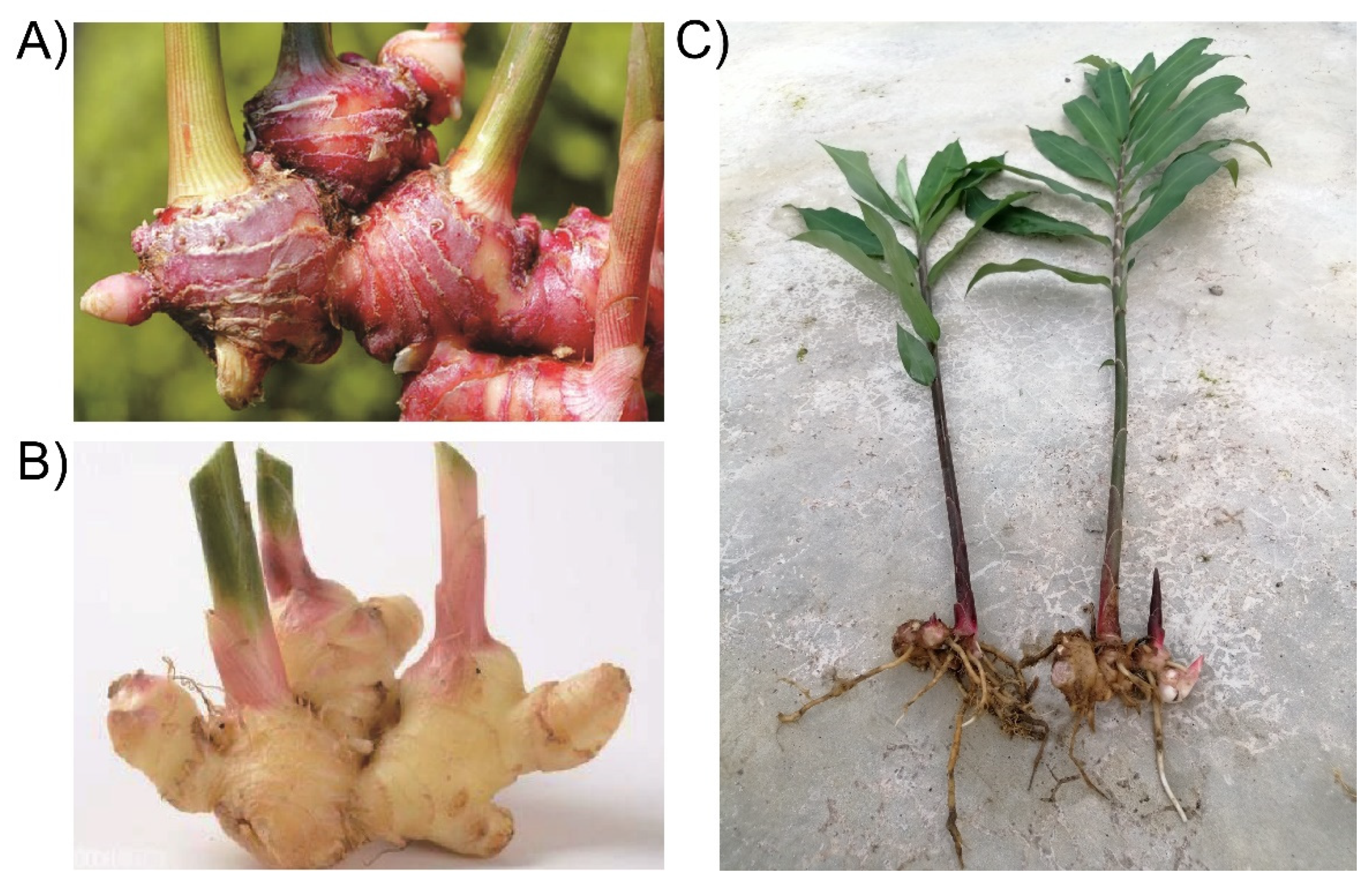
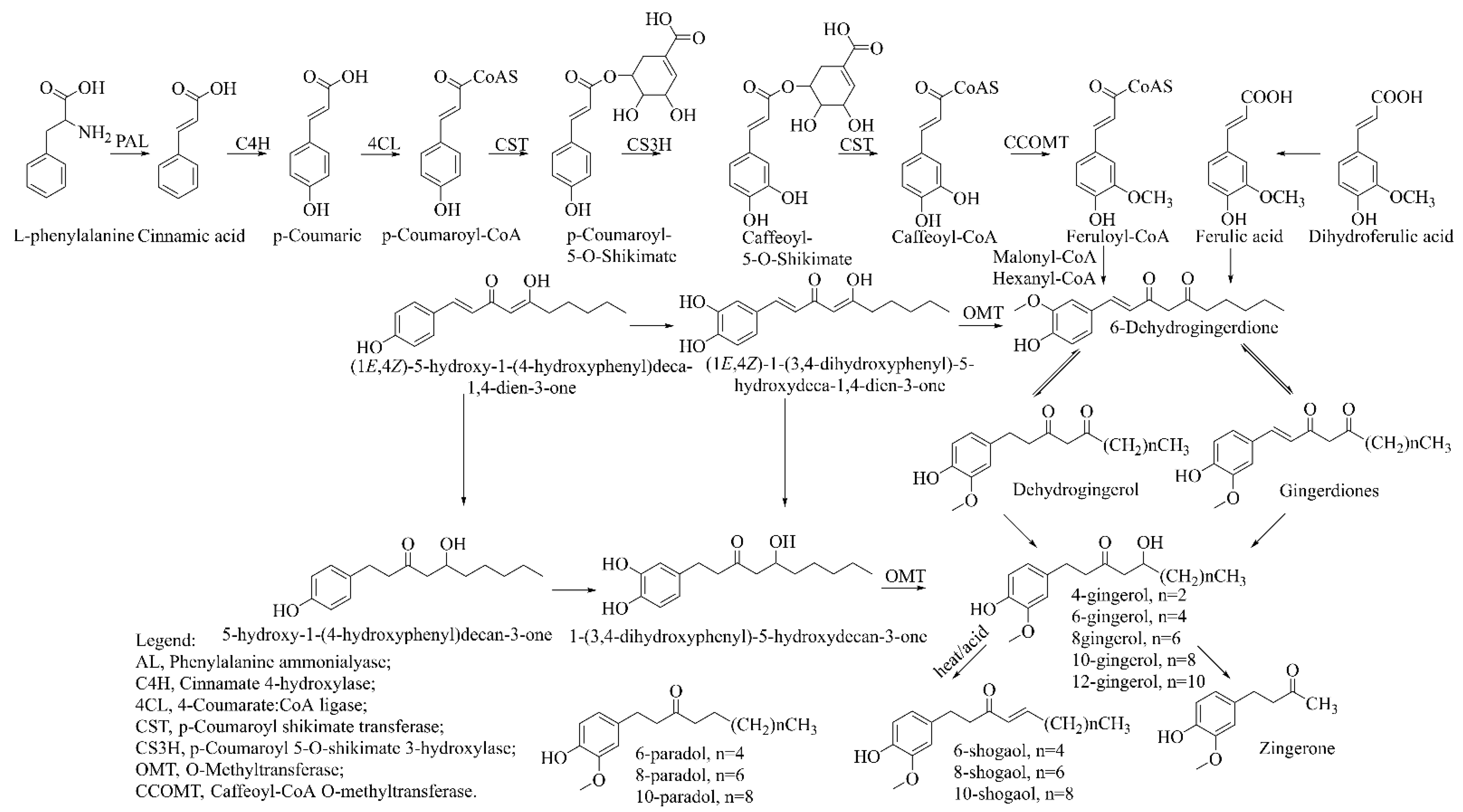



| Name | Chemical Structure |
|---|---|
| Vanilloids | |
| 6-Gingerol | 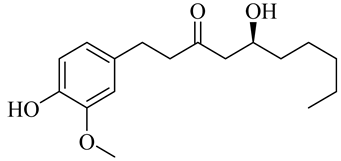 |
| 8-Gingerol | 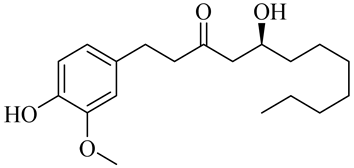 |
| 10-Gingerol | 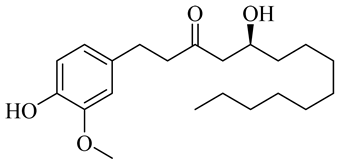 |
| 6-Shogaol | 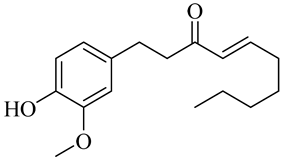 |
| 8-Shogaol | 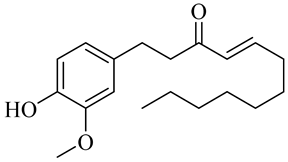 |
| 10-Shogaol |  |
| (3S,5S)-[6]-Gingerdiol |  |
| [6]-Gingerdiol 3S,5S-diacetate | 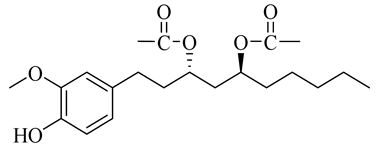 |
| (3R,5S)-[6]-Gingerdiol |  |
| [6]-Gingerdiol 3R,5S-diacetate | 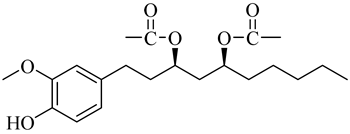 |
| (3S,5S)-[8]-Gingerdiol |  |
| [8]-Gingerdiol 3S,5S-diacetate | 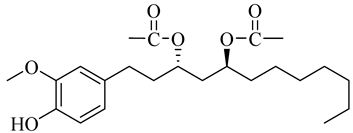 |
| (3R,5S)-[8]-Gingerdiol |  |
| [8]-Gingerdiol 3R,5S-diacetate | 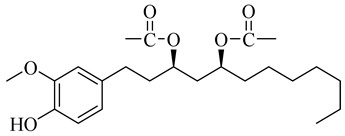 |
| (3S,5S)-[10]-Gingerdiol | 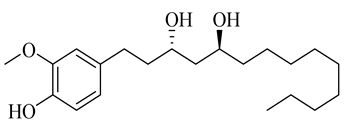 |
| [10]-Gingerdiol 3S,5S-diacetate | 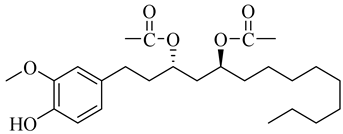 |
| (3R,5S)-[10]-Gingerdiol |  |
| [10]-Gingerdiol 3R,5S-diacetate |  |
| 5-Methoxy-1-(4-hydroxy-3-methoxyphenyl)-3-decanone |  |
| 5-Methoxy-1-(4-hydroxy-3-methoxyphenyl)-3-tetradecanone: |  |
| 1-(4-Hydroxy-3-methoxyphenyl)-3,5-decanediol |  |
| 4-Gingeracetate | 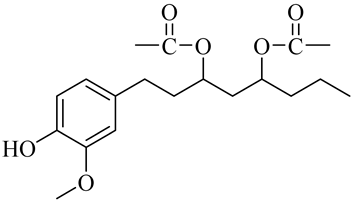 |
| 3-Hydroxy-1-(4-hydroxy-3-methoxyphenyl)-5-decanone | 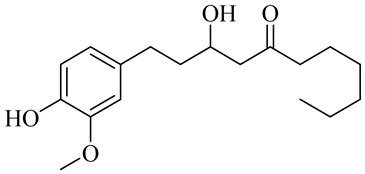 |
| 3,5-Diacetoxy-1-(4-hydroxy-3-methoxyphenyl)decane | 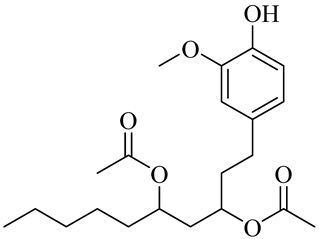 |
| 1-Dehydro-6-gingerdione |  |
| 6-Dehydro-gingerdione |  |
| Hexahydro-curcumin |  |
| Monoterpenes | |
| Tricyclene | 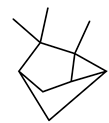 |
| α-Pinene |  |
| Camphene |  |
| Sabinene |  |
| β-pinene |  |
| α-Phellandrene | 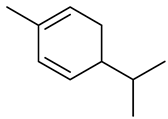 |
| p-Cymene | 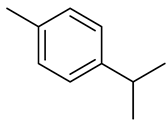 |
| β-Phellandrene | 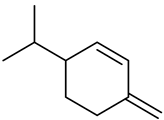 |
| γ-Terpinene |  |
| Terpinolene |  |
| Linalool |  |
| trans-3(10)-Caren-2-ol |  |
| 1,1-Dimethyl-3-methylene2-vinylcyclohexane |  |
| 2-Methoxy-1,7,7-trimethylbicyclo [2,2,1] heptane | 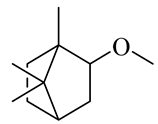 |
| Citronellal |  |
| Camphor |  |
| Borneol/Isoborneol | 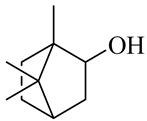 |
| 1-Terpinen-4-ol |  |
| α-Terpineol | 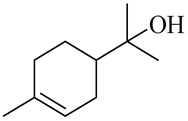 |
| Myrtenal |  |
| Citronellol |  |
| Neral/Z-citral |  |
| citral |  |
| trans-Geraniol |  |
| cis-p-Menth-2,8-dienol |  |
| Geranial |  |
| Cyclosativene | 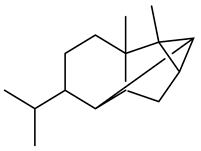 |
| Eucalyptol/1,8-Cineole |  |
| Geranyl acetate |  |
| Bornyl acetate | 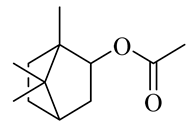 |
| Myrcene |  |
| Dipentene/Limonene | 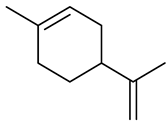 |
| Neryl acetate | 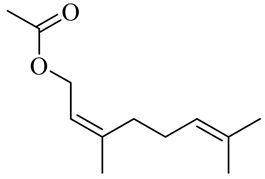 |
| Camphene hydrate | 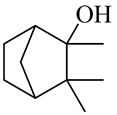 |
| Pulegone | 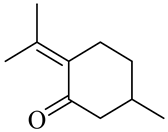 |
| Citronellyl acetate |  |
| trans-nerolidol |  |
| (-)-δ-3-carene |  |
| cis-β-Ocimene |  |
| trans-Sabinene hydrate |  |
| Linalyl formate |  |
| Myrtenyl acetate |  |
| Sesquiterpenes | |
| α-Copaene | 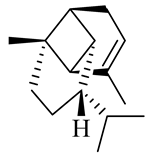 |
| β-Elemene |  |
| α-trans-Bergamotene |  |
| β-Cubebene | 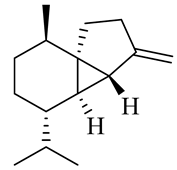 |
| β-Farnesene |  |
| Cedrene | 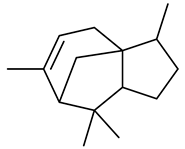 |
| Allo-aromadendrene | 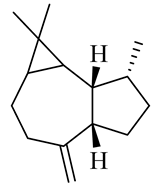 |
| β-Himachalene |  |
| α-Curcumene | 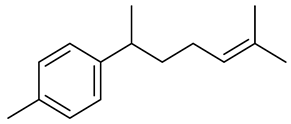 |
| Zingiberene | 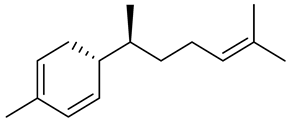 |
| α-Farnesene |  |
| β-Bisabolene | 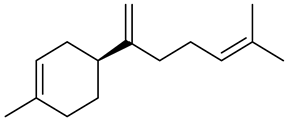 |
| β-Sesquiphellandrene | 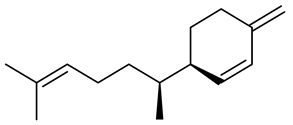 |
| α-Panasinsen | 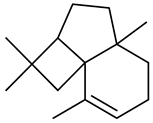 |
| Germacrene B | 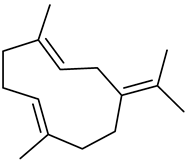 |
| epi-Globulol | 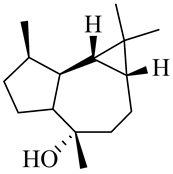 |
| Cubenol | 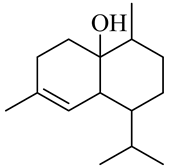 |
| τ-Eudesmol | 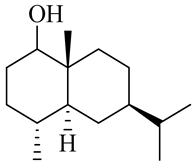 |
| Caryophyllene oxide | 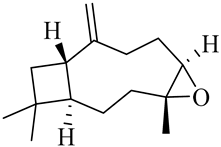 |
| τ-Muurolol | 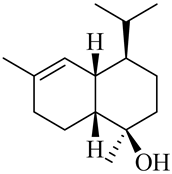 |
| α-Cadinol | 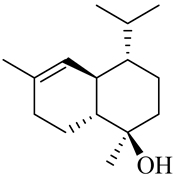 |
| Spathulenol | 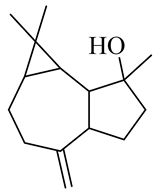 |
| Cedr-8-ene | 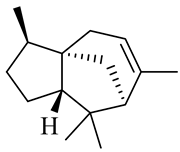 |
| β-Cedren-9-α-ol | 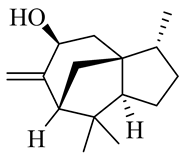 |
| Farnesal |  |
| δ-Elemene | 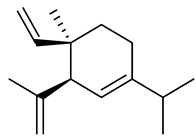 |
| α-Caryophyllene | 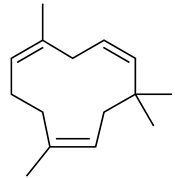 |
| β-Caryophyllene |  |
| Bisabolene |  |
| α-Humulene | 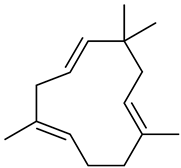 |
| β-funebrene | 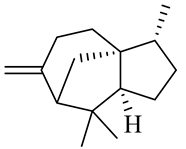 |
| Sesquithujene | 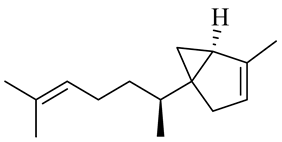 |
| Calarene/Beta-gurjunene | 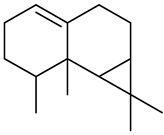 |
| cis-nerolidol | 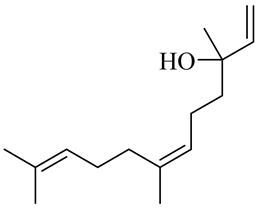 |
| Elemol | 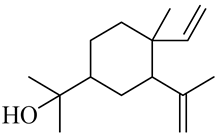 |
| β-Atlantone | 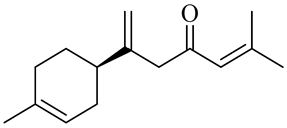 |
| β-Eudesmol | 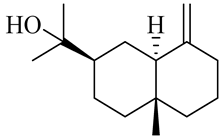 |
| β-Bisabolol |  |
| 4-(1,5-Dimethylhex-4-enyl)cyclohex-2-enone | 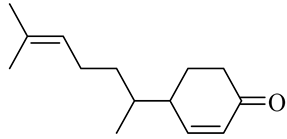 |
| (2Z,6E)-Farnesol | 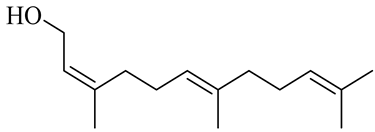 |
| (2Z,6Z)-Farnesol | 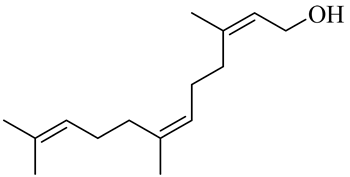 |
| (2E,6E)-Farnesol |  |
| Isocaryophyllene | 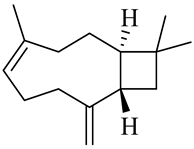 |
| α-Humulene | 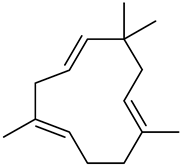 |
| Germacrene D | 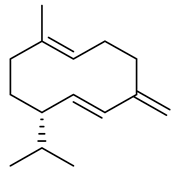 |
| α-Selinene | 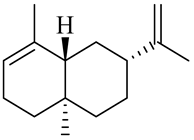 |
| α-Muurolene | 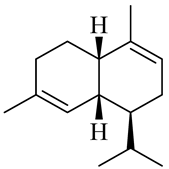 |
| δ-Cadinene | 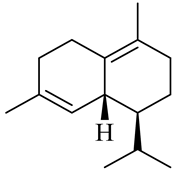 |
| γ-Eudesmol | 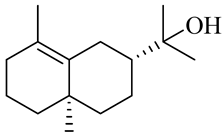 |
| α-Bisabolol |  |
| Caryophyllenol | 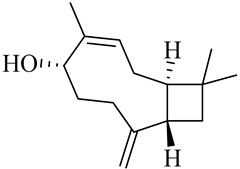 |
| Diterpene | |
| Phytol | 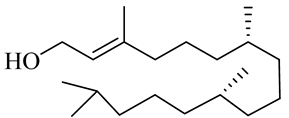 |
| Flavonoids | |
| Rutin | 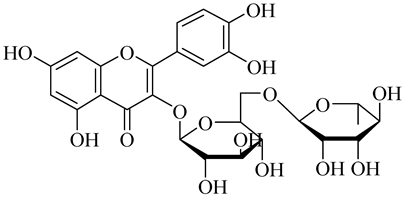 |
| Apigenin | 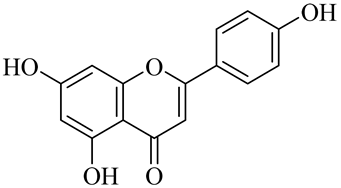 |
| Myricetin |  |
| Naringenin | 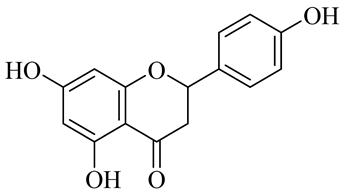 |
| Fisetin |  |
| Morin | 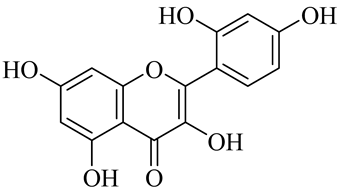 |
| Flavylium/Anthocyanin | 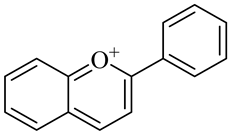 |
| Quercetin | 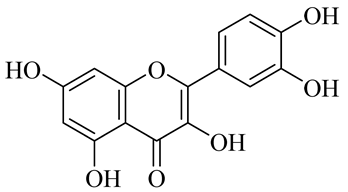 |
| (−)-Epicatechin | 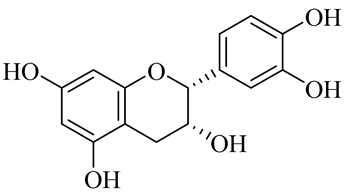 |
| (+)- Catechin | 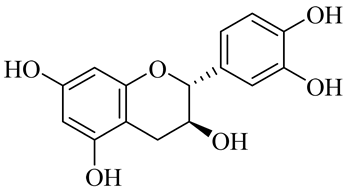 |
| Kaempferol | 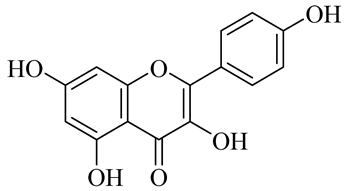 |
| Naringenin | 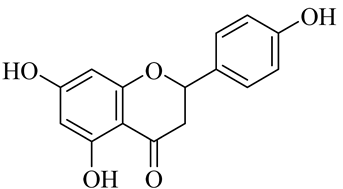 |
| Organic acids | |
| Salicylic acid | 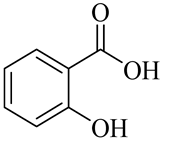 |
| Cinnamic acid | 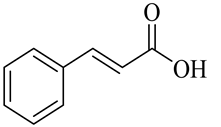 |
| Gallic acid | 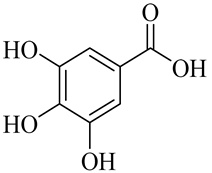 |
| Vanillic acid | 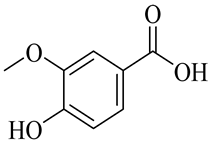 |
| Ferulic acid |  |
| Tannic acid | 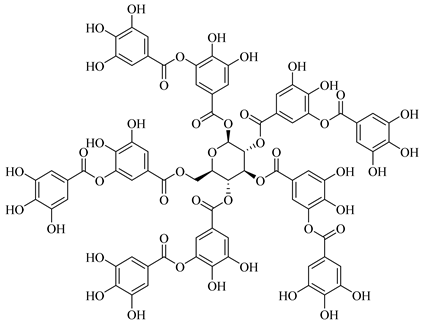 |
| Caffeic acid | 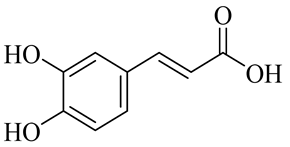 |
| Ethyl cinnamate | 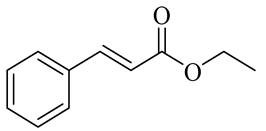 |
| Ethyl p-methoxycinnamate | 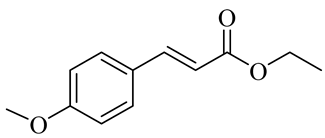 |
| (2R,4S,5R)-2-(Acetoxymethyl)-6-(2-methoxy-4-((E)-3-oxodec-4-en-1-yl)phenoxy)tetrahydro-2H-pyran-3,4,5-triyl triacetate | 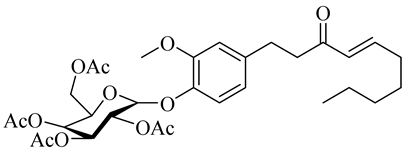 |
| (E)-1-(3-Methoxy-4-(((3R,4S,6R)-3,4,5-trihydroxy-6-(hydroxymethyl)tetrahydro-2H-pyran-2-yl)oxy)phenyl)dec-4-en-3-one | 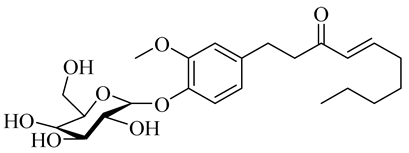 |
| (2R,4S,5R)-2-(Acetoxymethyl)-6-(4-(5-hydroxy-3-oxodecyl)-2-methoxyphenoxy)tetrahydro-2H-pyran-3,4,5-triyl triacetate | 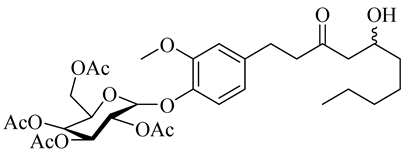 |
| 5-Hydroxy-1-(3-methoxy-4-(((3R,4S,6R)-3,4,5-trihydroxy-6-(hydroxymethyl)tetrahydro-2H-pyran-2-yl)oxy)phenyl)decan-3-one | 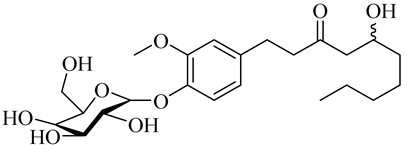 |
| Amino acids | |
| Glutamine | 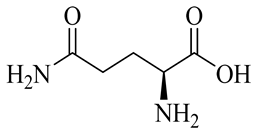 |
| Histidine | 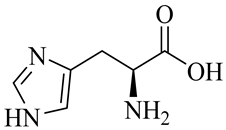 |
| Glutamic acid | 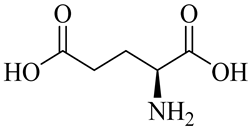 |
| Threonine | 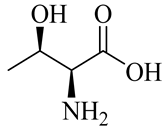 |
| Leucine | 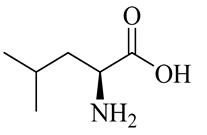 |
| Lysine | 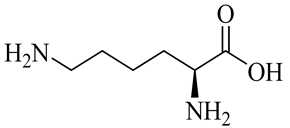 |
| Valine | 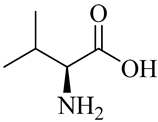 |
| Tyrosine | 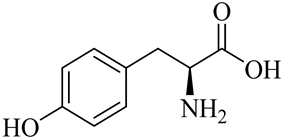 |
| Miscellaneous | |
| 2-Undecanone |  |
| 2-Heptanol |  |
| Octanal |  |
| (E)-2-Octenal |  |
| 3,4-Dimethyl styrene |  |
| Naphthalene |  |
| Cumene Isopropylbenzene |  |
| 6-Hepten-3-one |  |
| Naphthalene |  |
| Tridecane |  |
| 6-Methyl-5-hepten-2-oneSulcatone |  |
| Nonanone |  |
| 2-Heptyl acetate |  |
| Trans-2-decenal |  |
| Bioactivity | Mechanism | Responsible Constituents | Ref. |
|---|---|---|---|
| Antimicrobial activity | Anti-gram negative Anti-gram positive Natural preservative | β-caryophyllene | [33] |
| Analgesic activity | Hyperalgesia↓ γ-aminobutyric acid↓ NR2B↓ | Camphene Cineole Geranial Geranyl acetate | [34,35,36] |
| Antidiabetic activity | α-amylase α-glucosidase | Gingerols shogaols | [37] |
| Anti-inflammatory | Prostaglandins↓ leukotrienes↓ COX-1↓ COX-2↓ 5-LO↓ TNF-α↓ NO↓ iNOS↓ NF-κb↓ TPA↓ ODC↓ | 6-gingerol 6-shogaol 8-gingerol 10-gingerol | [19,38,39,40,41,42] |
| Antioxidant | Donating electrons or a hydrogen atom to free radical | Phenolic compounds Quercetin 6-shogaol 8-shogaol 6-gingerol 8-gingerol 10-gingerol | [19,43,44,45] |
| Melanogenesis inhibitory activity | Melanogenesis inhibitory activity | Gingerdione | [25] |
| Anticancer and antitumor activity | Angiogenesis and metastasis | 6-shogaol 6-gingerol | [46,47,48,49,50,51] |
| Antihyperlipidemic | LDL-C↓ ACE↓ HDL-C↓ malondialdehyde↓ | Gingerol Shogaol Gingerdione | [52,53] |
| Anti-hypercholesterolemia | LDL↑, HMG-CoA↑, HDL↑ | Phenolic compounds | [54] |
| Antihypertensive | NO↑ Prostacyclin Release Ca2+ Activation of cGMP-KATP Stimulation of muscarinic receptors | 6-gingerol 6-shogaol gingerdione | [30] |
| Anti-Alzheimer’s disease | HDAC↓, Trichostatin A↓, MS275↓, AChE↑, α-secretase↓, Aβ-42↓, β-secretase↓, APH1a↑ | Flavonoids Tannins Alkaloids 6-shogaol terpenoids | [20,53,55,56,57,58] |
| Androgenic effect | Pre-leptotene↑, pachytene spermatocytes↑ | Arginine Shogaol Gingerdiol Gingerol Zingerone Zingiber | [59,60,61] |
| Insecticidal activity | Zingerone and benzaldehyde dimethyl thiol acetal | Zingerone Benzaldehyde dimethyl thiol acetal | [62] |
| Immunomodulatory | Recover small intestine mucosa structure of mice Protective effect on dopaminergic neurons | Phenols | [63] |
Publisher’s Note: MDPI stays neutral with regard to jurisdictional claims in published maps and institutional affiliations. |
© 2022 by the authors. Licensee MDPI, Basel, Switzerland. This article is an open access article distributed under the terms and conditions of the Creative Commons Attribution (CC BY) license (https://creativecommons.org/licenses/by/4.0/).
Share and Cite
Zhang, S.; Kou, X.; Zhao, H.; Mak, K.-K.; Balijepalli, M.K.; Pichika, M.R. Zingiber officinale var. rubrum: Red Ginger’s Medicinal Uses. Molecules 2022, 27, 775. https://doi.org/10.3390/molecules27030775
Zhang S, Kou X, Zhao H, Mak K-K, Balijepalli MK, Pichika MR. Zingiber officinale var. rubrum: Red Ginger’s Medicinal Uses. Molecules. 2022; 27(3):775. https://doi.org/10.3390/molecules27030775
Chicago/Turabian StyleZhang, Shiming, Xuefang Kou, Hui Zhao, Kit-Kay Mak, Madhu Katyayani Balijepalli, and Mallikarjuna Rao Pichika. 2022. "Zingiber officinale var. rubrum: Red Ginger’s Medicinal Uses" Molecules 27, no. 3: 775. https://doi.org/10.3390/molecules27030775
APA StyleZhang, S., Kou, X., Zhao, H., Mak, K.-K., Balijepalli, M. K., & Pichika, M. R. (2022). Zingiber officinale var. rubrum: Red Ginger’s Medicinal Uses. Molecules, 27(3), 775. https://doi.org/10.3390/molecules27030775






